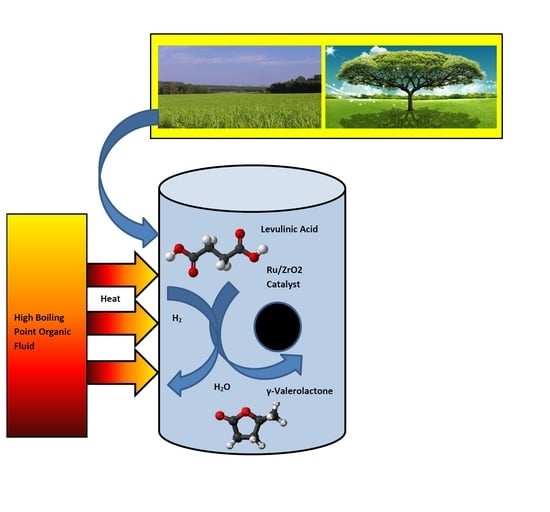CFD Design of Hydrogenation Reactor for Transformation of Levulinic Acid to γ-Valerolactone (GVL) by using High Boiling Point Organic Fluids
Abstract
:1. Introduction
1.1. GVL Production Process Catalysts
1.2. CFD Simulations of Biofuel Production
1.3. Critical Heat Flux of Water
2. Materials and Methods
2.1. High Temperature Fluids
2.2. Properties and Benefits of Utilization of an Organic Fluid
2.3. Multiphysics Analyses of the Hydrogenation Reactor
2.3.1. Model Kinetics
2.3.2. Fluid Flow and Continuity Equations
2.3.3. Energy Transport Equation
2.3.4. Diffusion Transport Equation
3. Results
3.1. Model Validation
3.2. Calculated Results for Lower Temperatures
4. Discussion
5. Conclusions
Funding
Conflicts of Interest
Appendix A. Preliminary Results for Fire Dynamics Simulator of GVL Burner
| Material Property | Value |
|---|---|
| Lower Heating value | 25,000 (kJ/kg) |
| density | 1040 (kg/m³) |
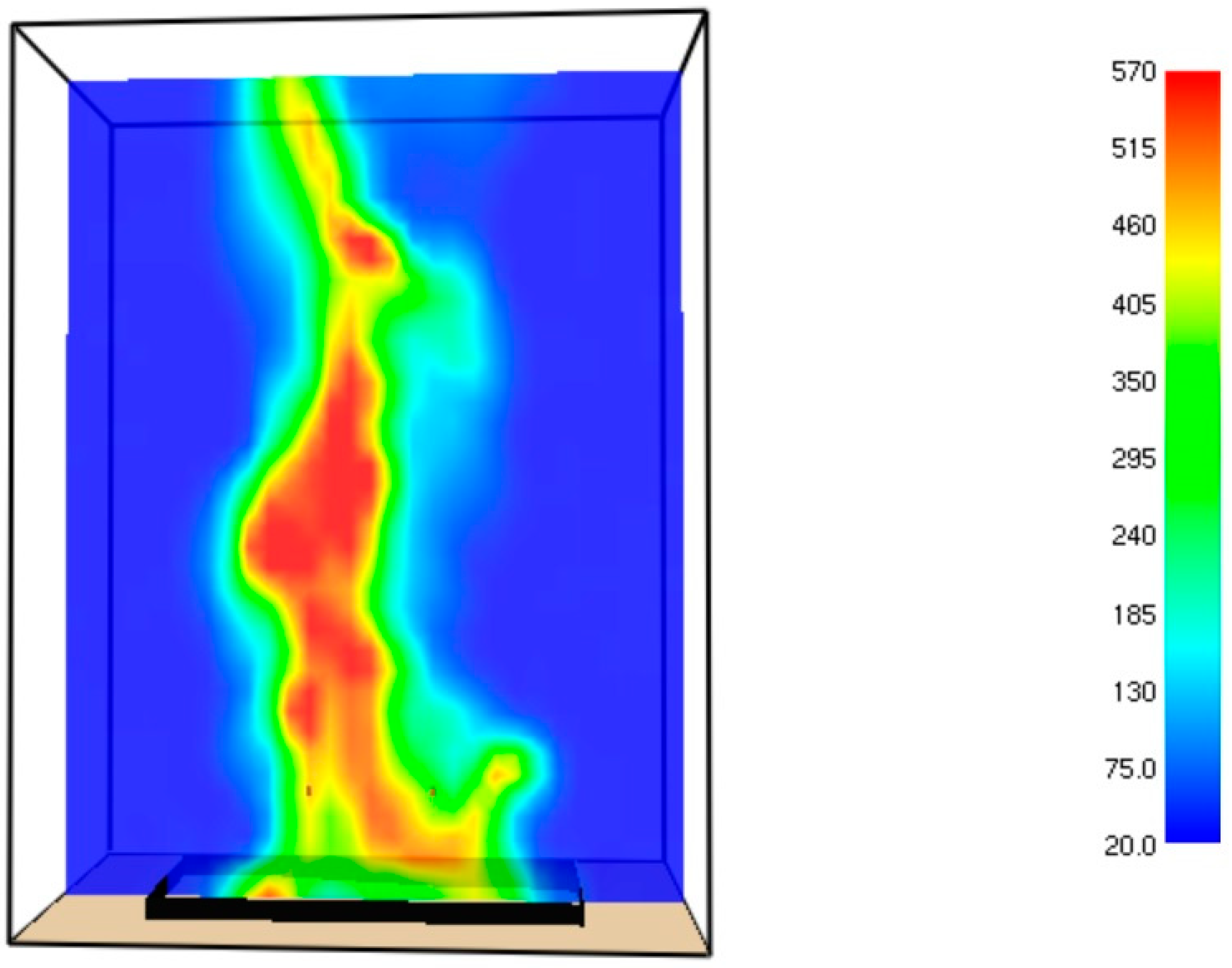
References
- Jones, D.R.; Iqbal, S.; Thomas, L.; Ishikawa, S.; Reece, C.; Miedziak, P.J.; Morgan, D.J.; Bartley, J.K.; Willock, D.J.; Ueda, W.; et al. xNi–yCu–ZrO2 catalysts for the hydrogenation of levulinic acid to gamma valorlactone. Catal. Struct. React. 2018, 4, 12–23. [Google Scholar] [CrossRef]
- Bozell, J.J.; Petersen, G.R. Technology development for the production of biobased products from biorefinery carbohydrates—The US Department of Energy’s “Top 10” revisited. Green Chem. 2010, 12, 539–554. [Google Scholar] [CrossRef]
- Corma, A.; Iborra, S.; Velty, A. Chemical routes for the transformation of biomass into chemicals. Chem Rev. 2007, 107, 2411–2502. [Google Scholar] [CrossRef] [PubMed]
- Paul, S.F. Alternative Fuel. Patent WO1997043356 A1, 16 December 1997. [Google Scholar]
- Horváth, I.T. Gamma-Valerolactone: A Sustainable Liquid for Energy and Carbon Based Chemicals. In Proceedings of the 10th Annual Green Chemistry and Engineering Conference, Washington, DC, USA, 26–30 June 2006. [Google Scholar]
- Horváth, I.T.; Mehdi, H.; Fábos, V.; Boda, L.; Mika, L.T. γ-Valerolactone—A sustainable liquid for energy and carbon-based chemicals. Green Chem. 2008, 10, 238–242. [Google Scholar] [CrossRef]
- Bereczky, Á.; Lukács, K.; Farkas, M.; Dóbé, S. Effect of γ-Valerolactone Blending on Engine Performance, Combustion Characteristics and Exhaust Emissions in a Diesel Engine. Nat. Resour. 2014, 5, 177–191. [Google Scholar]
- Licursi, D.; Antonetti, C.; Fulignati, S.; Giannoni, M.; Raspolli Galletti, A.M. Cascade Strategy for the Tunable Catalytic Valorization of Levulinic Acid and γ-Valerolactone to 2-Methyltetrahydrofuran and Alcohols. Catalysts 2018, 8, 277. [Google Scholar] [CrossRef]
- Chalid, M.; Broekhuis, A.A.; Heeres, H.J. Experimental and kinetic modeling studies on the biphasic hydrogenation of levulinic acid to γ-valerolactone using a homogeneous water-soluble Ru–(TPPTS) catalyst. J. Mol. Catal. A Chem. 2011, 341, 14–21. [Google Scholar] [CrossRef]
- Filiz, B.C.; Gnanakumar, E.S.; Martinez-Arias, A.; Gengler, R.; Rudolf, P.; Rothenberg, G.; Shiju, N.R. Highly Selective Hydrogenation of Levulinic Acid to gamma-Valerolactone Over Ru/ZrO2 Catalysts. Catal. Lett. 2017, 147, 1744–1753. [Google Scholar] [CrossRef]
- Ftouni, J.; Muñoz-Murillo, A.; Goryachev, A.; Hofmann, J.P.; Hensen, E.J.M.; Lu, L.; Kiely, C.J.; Bruijnincx, P.C.A.; Weckhuysen, B.M. ZrO2 Is Preferred over TiO2 as Support for the Ru-Catalyzed Hydrogenation of Levulinic Acid to γ-Valerolactone. ACS Catal. 2016, 6, 5462–5472. [Google Scholar] [CrossRef]
- Wensel, P.; Yu, L.; Chen, S. Simulation with Computational Fluid Dynamics of Succinic Acid and Co-Product Bio-refinery Process. J. Bioprocess. Bio-Tech. 2011. [Google Scholar] [CrossRef]
- Gorshkova, E.; Manninen, M.; Alopaeus, V.; Laavi, H.; Koskinen, J. Three-Phase CFD-Model for Trickle Bed Reactors. Int. J. Nonlinear Sci. Numer. Simul. 2012, 13, 397–404. [Google Scholar] [CrossRef]
- Bergman, T.L.; Incropera, F.P.; DeWitt, D.P.; Lavine, A.S. Fundamentals of Heat and Mass Transfer; John Wiley&Sons: Hoboken, NJ, USA, 2011. [Google Scholar]
- Hu, H.; Xu, C.; Zhao, Y.; Ziegler, K.J.; Chung, J.N. Boiling and quenching heat transfer advancement by nanoscale surface modification. Sci. Rep. 2017, 7, 6117. [Google Scholar] [CrossRef] [PubMed]
- Sharar, D.; Jankowski, N; Bar Cohen, A. Two Phase Fluid Selection for High Temperature Automotive Platforms; ARL-TR-6171; U.S. Army Research Laboratory (ARL): Adelphi, MD, USA, 2012. [Google Scholar]
- Dowtherm, A. Heat Transfer Fluid, Product Technical Tool. Available online: http://www.dow.com/heattrans (accessed on 4 February 2017).
- Abagnale, C.; Cameretti, M.C.; De Robbio, R.; Tuccillo, R. Thermal Cycle and Combustion Analysis of a Solar-Assisted Micro Gas Turbine. Energies 2017, 10, 773. [Google Scholar] [CrossRef]
- Trolove, H.P. Line Focus Solar Stirling Domestic Power Generation. Master’s Thesis, Mechanical Engineering, Department of Mechanical Engineering, University of Canterbury, Canterbury, New Zealand, 1994. [Google Scholar]
- Davidy, A. Proposal of an Alternative UAV Engine Organic Coolants. Preprints 2018, 2018060048. [Google Scholar] [CrossRef]
- Abdelrahman, O.A.; Heyden, A.; Bond, J.Q. Analysis of Kinetics and Reaction Pathways in the Aqueous-Phase Hydrogenation of Levulinic Acid To Form γ-Valerolactone over Ru/C. ACS Catal. 2014, 4, 1171–1181. [Google Scholar] [CrossRef]
- COMSOL Multiphysics—Modeling Guide; Version 4.3b; COMSOL AB: Stockholm, Sweden, 2013.
- Vasiliu, M.; Guynn, K.; Dixon, D.A. Prediction of the Thermodynamic Properties of Key Products and Intermediates from Biomass. J. Phys. Chem. C 2011, 115, 15686–15702. [Google Scholar] [CrossRef]
- Sorrentino, G.; Ceriello, G.; de Joannon, M.; Sabia, P.; Ragucci, R.; Van Oijen, J.; Cavaliere, A.; De Goey, L.P.H. Numerical Investigation of Moderate or Intense Low-Oxygen Dilution Combustion in a Cyclonic Burner Using a Flamelet—Generated Manifold Approach. Energy Fuels 2018, 32, 10242–10255. [Google Scholar] [CrossRef]
- Bao, Z. Performance investigation and optimization of metal hydride reactors for high temperature thermochemical heat storage. Int. J. Hydrogen Energy 2015, 40, 5664–5676. [Google Scholar] [CrossRef]
- Piskun, A.S. Support Screening Studies on the Hydrogenation of Levulinic Acid to γ-Valerolactone in Water Using Ru Catalysts—Chapter 2. In Catalytic Conversion of Levulinic Acid to γ-Valerolactone Using Supported Ru Catalysts: from Molecular to Reactor Level [Groningen]; Rijksuniversiteit: Groningen, The Netherland, 2016. [Google Scholar]
- Koeslag, M. Catalytic Hydrogenation of Levulinic Acid to γ-Valerolactone in a Trickle Bed Reactor, Analysis of Mass Transfer Resistance and Kinetics. Master’s Thesis, University of Groningen, Groningen, Netherlands, 2016. [Google Scholar]
- Piskun, A.; Winkelman, J.G.M.; Tang, Z.; Heeres, H.J. Support Screening Studies on the Hydrogenation of Levulinic Acid to γ-Valerolactone in Water Using Ru Catalysts. Catalysts 2016, 6, 131. [Google Scholar] [CrossRef]
- McGrattan, K. Fire Dynamics Simulator (Version 5)—Technical Reference Guide Volume 1: Mathematical Model; NIST Special Publication 1018; National Institute of Standards and Technology U.S. Department of Commerce: Washington, DC, USA, 2010.
- McGrattan, K.; Forney, G.P. Fire Dynamics Simulator (Version 5)—User’s Guide; NIST Special Publication 1019; National Institute of Standards and Technology U.S. Department of Commerce: Washington, DC, USA, 2010.
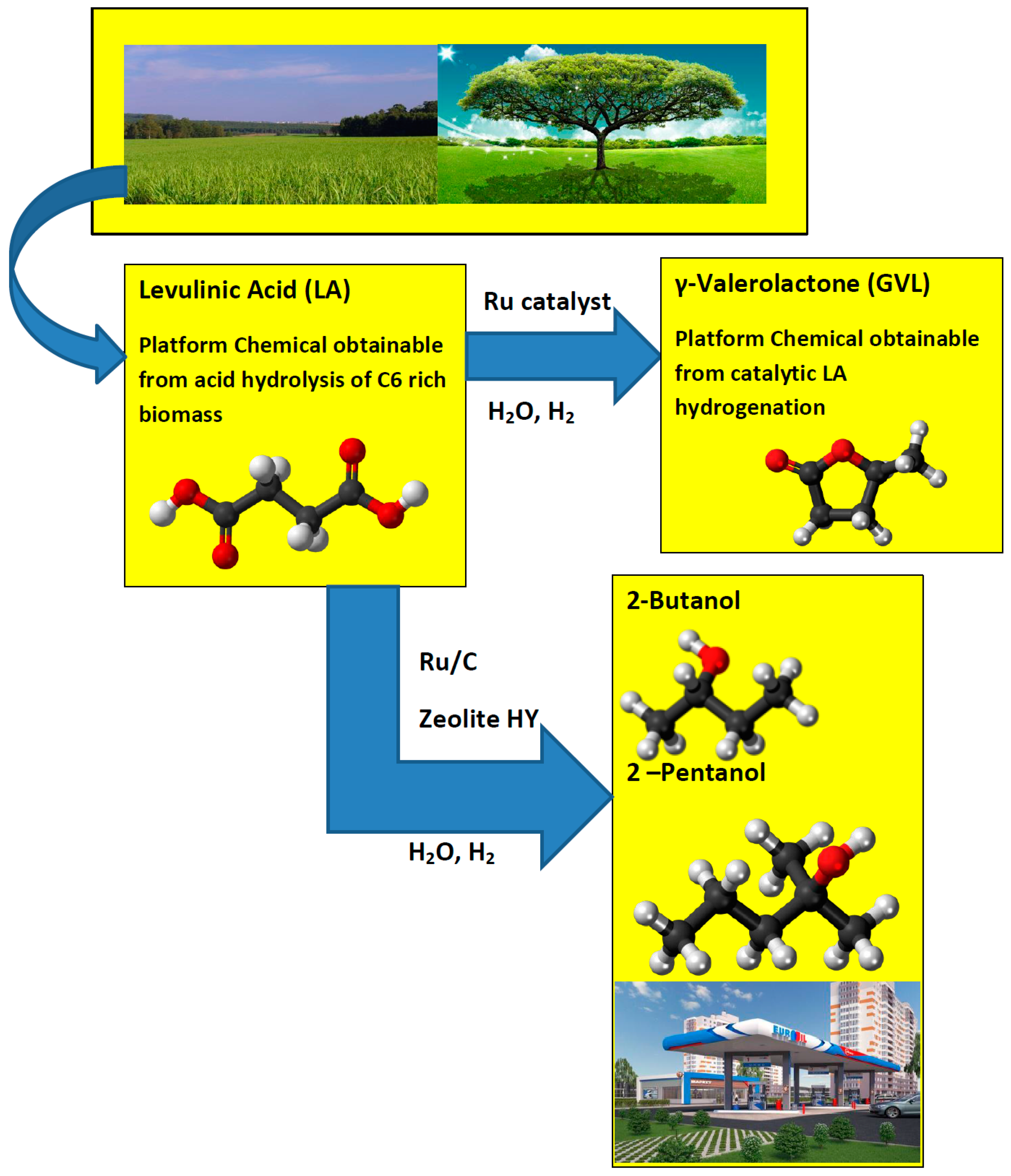
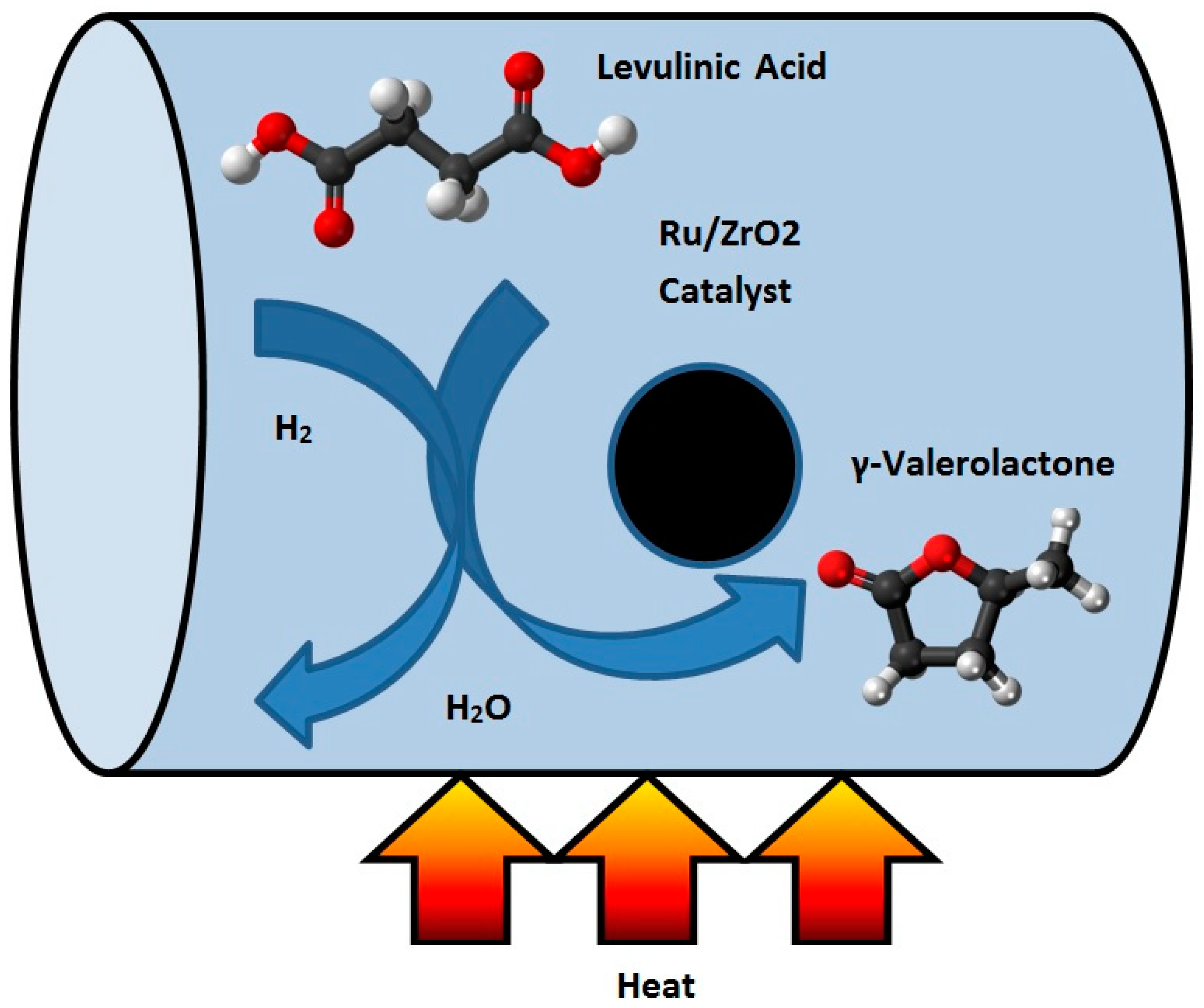
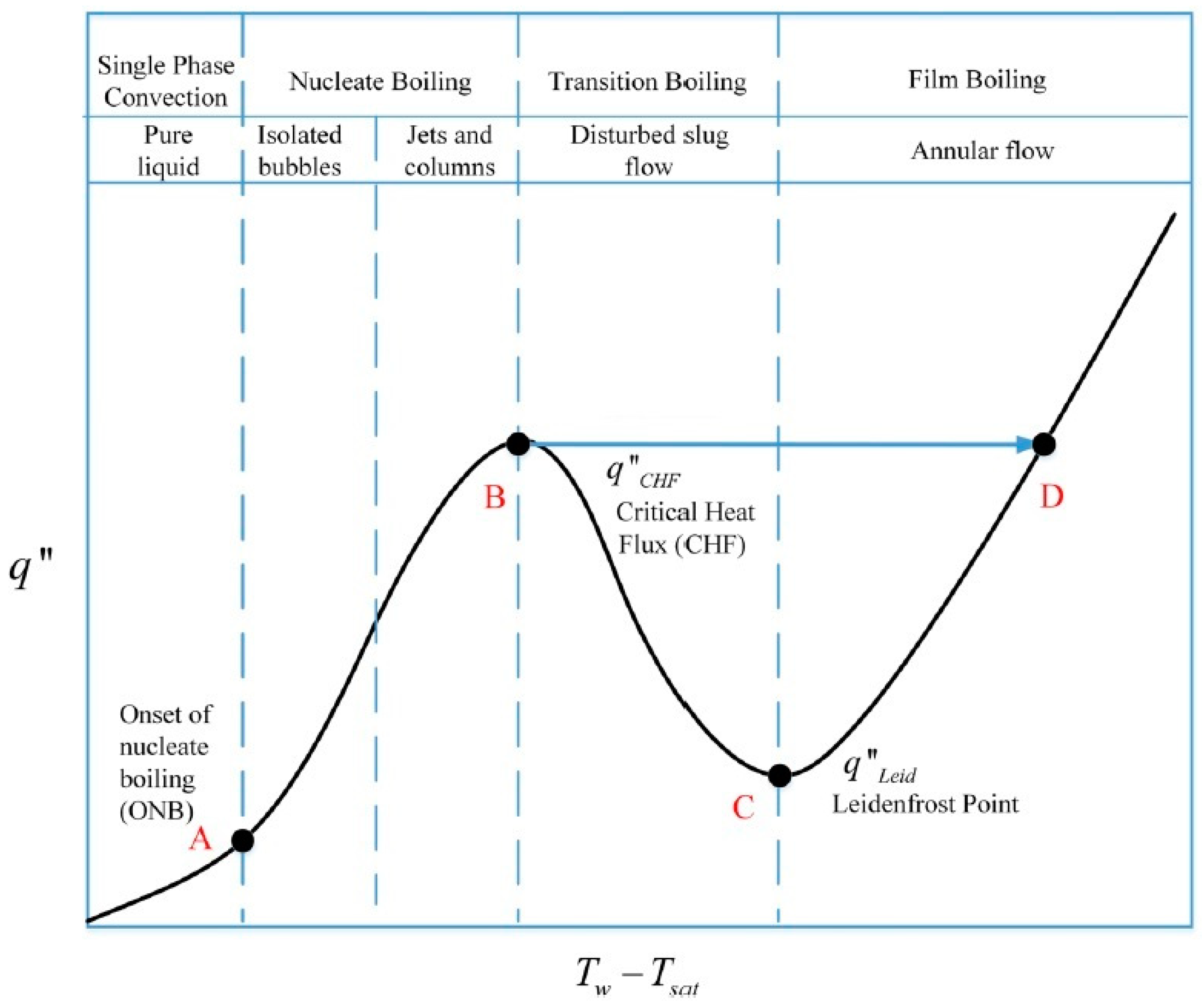
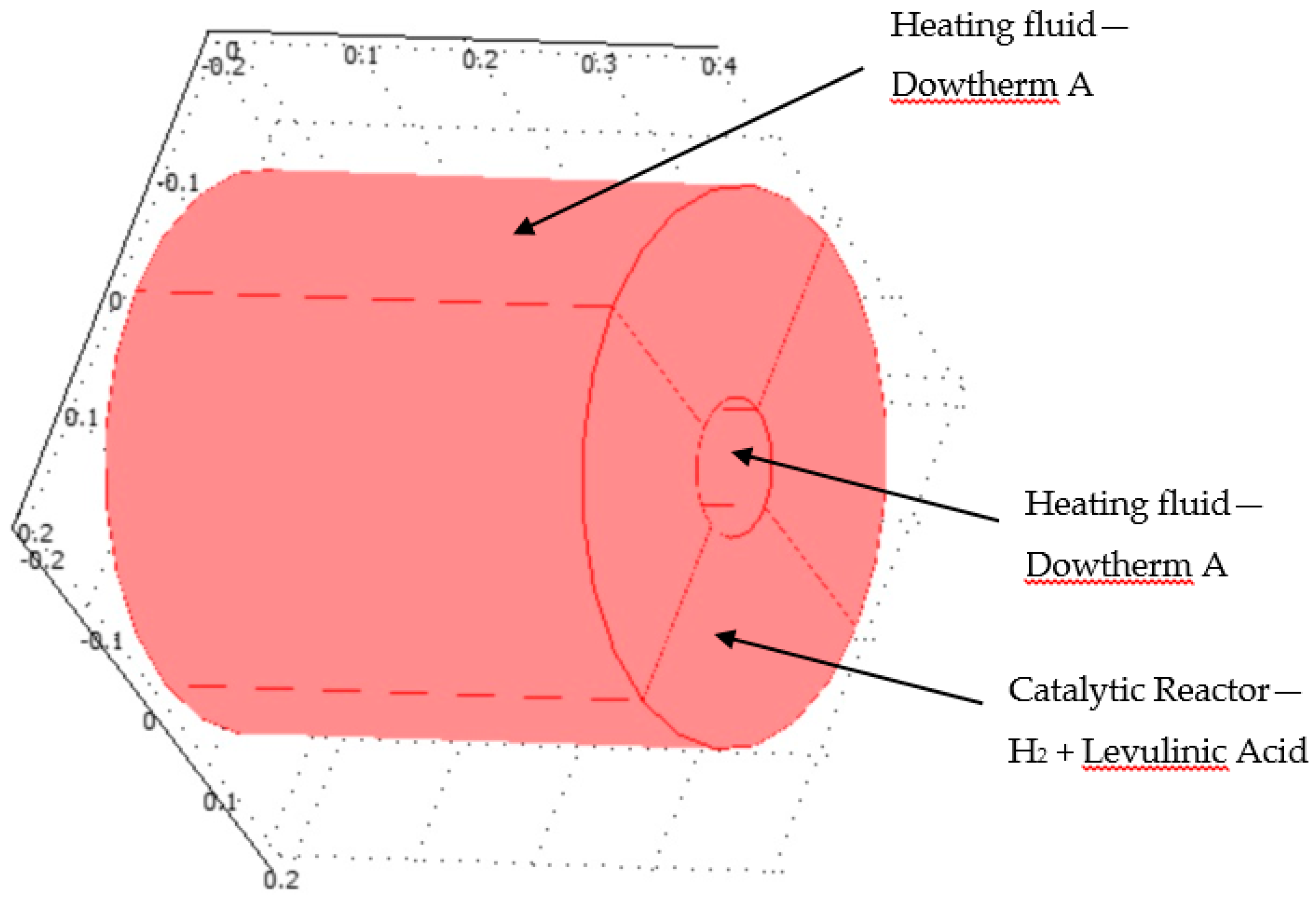
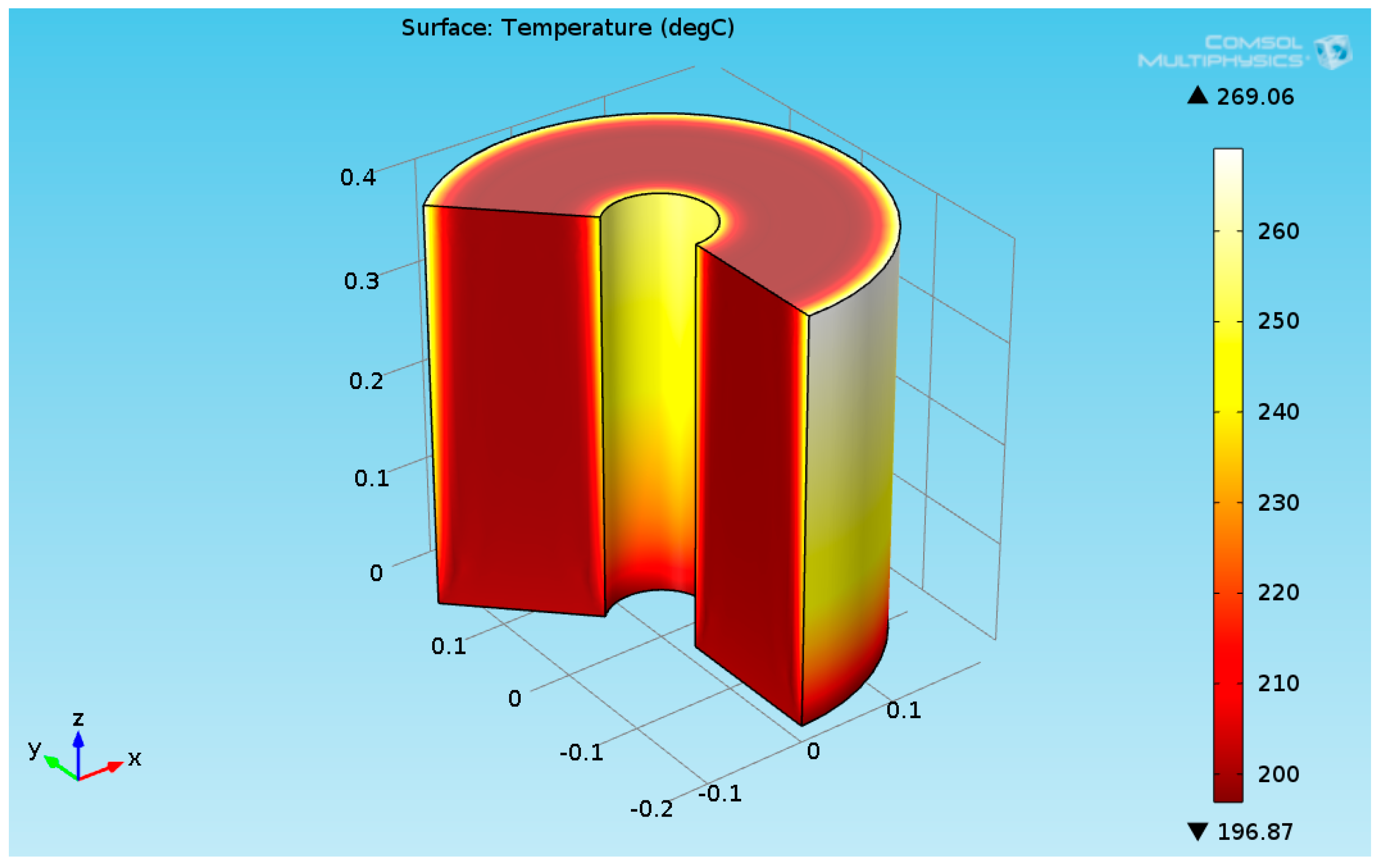
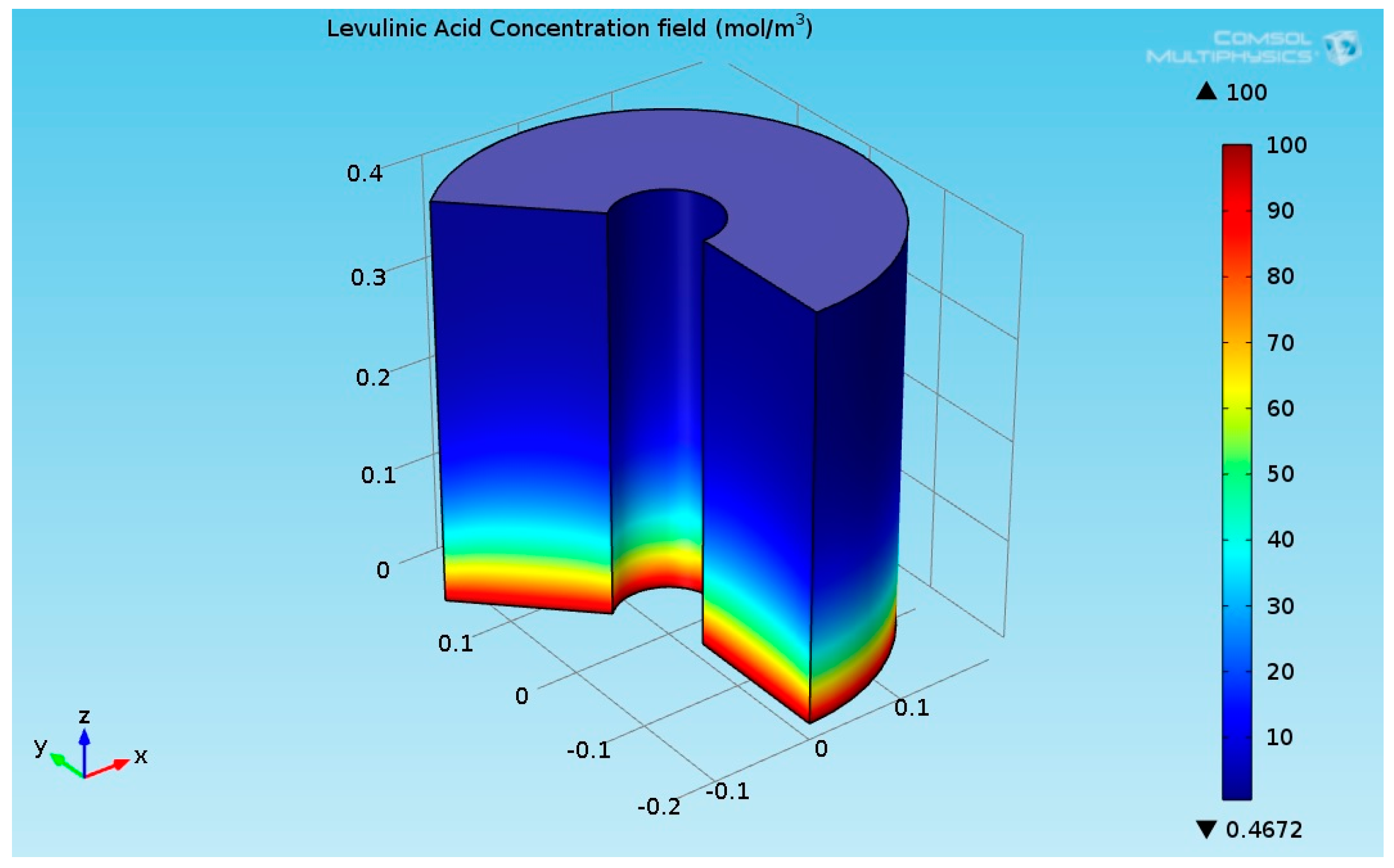
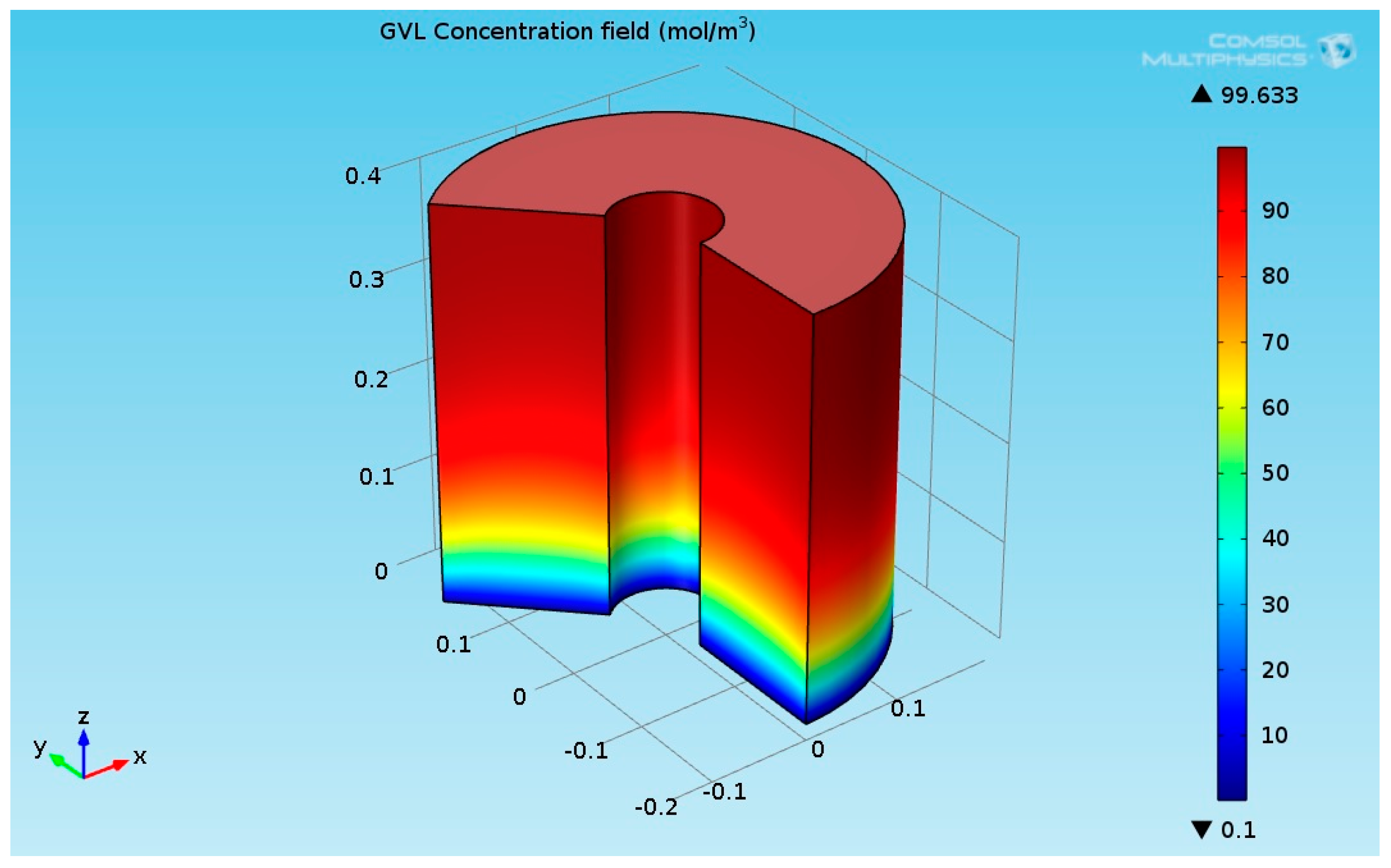
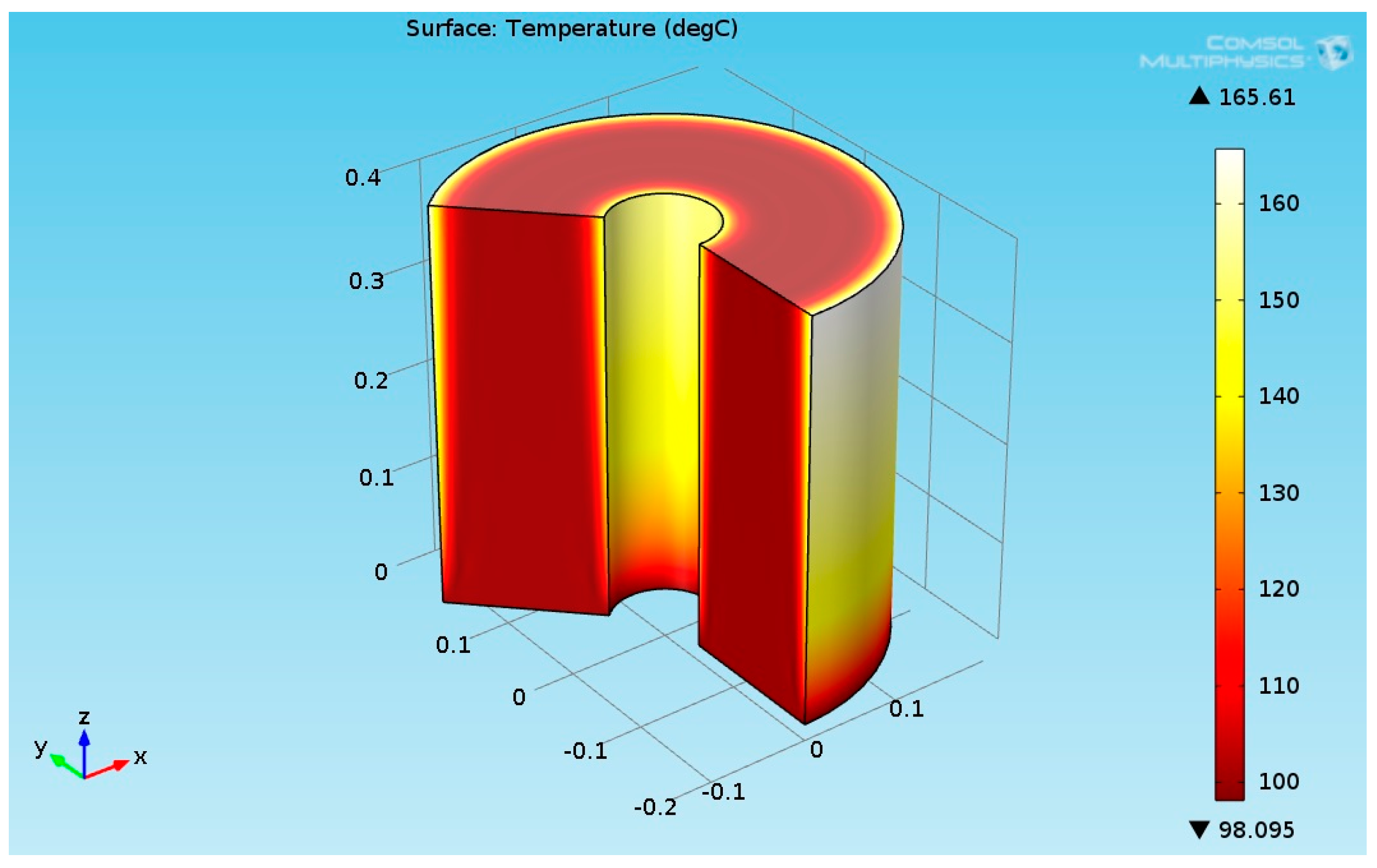
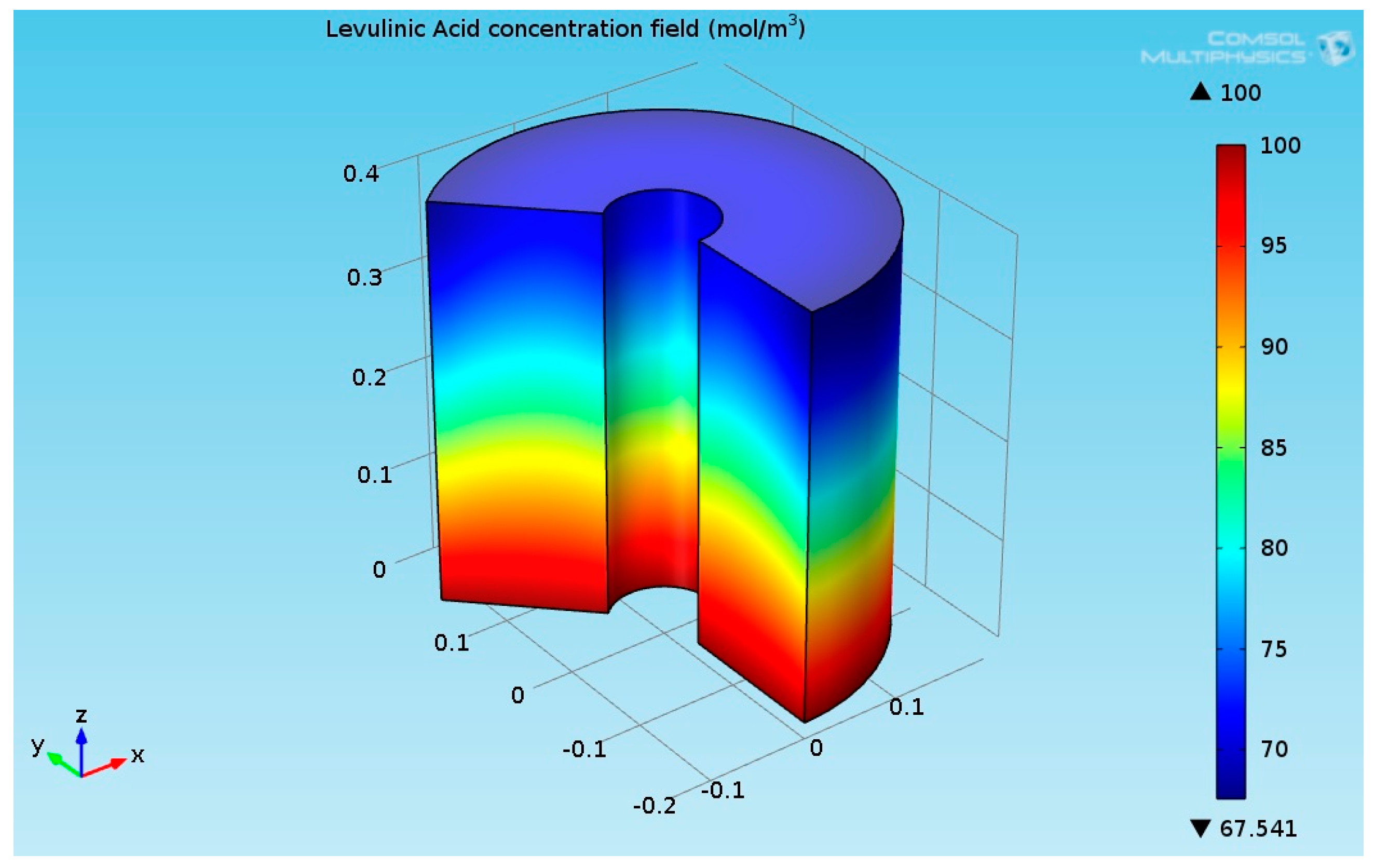

| Fluid | Boiling Point (°C) |
|---|---|
| Acetic acid anhydride | 139 |
| Alcohol | 97–117 |
| Aniline | 184 |
| Butyric acid n | 162 |
| Carbonic Acid | 182 |
| Dowtherm | 258 |
| Glycerin | 290 |
| Ethylene bromide | 131 |
| Ethylene glycol | 197 |
| Iodine | 184 |
| Jet Fuel | 163 |
| Kerosene | 150–300 |
| Mercury | 359 |
| Napthalene | 218 |
| Nitric Acid | 120 |
| Nitrobenzene | 210 |
| Nonane-n | 150 |
| Octane-n | 125 |
| Olive oil | 300 |
| Petroleum | 210 |
| Propionic Acid | 141 |
| Propylene Glycol | 187 |
| Toluene | 110 |
| Turpentine | 160 |
| Xylene-o | 142 |
© 2019 by the author. Licensee MDPI, Basel, Switzerland. This article is an open access article distributed under the terms and conditions of the Creative Commons Attribution (CC BY) license (http://creativecommons.org/licenses/by/4.0/).
Share and Cite
Davidy, A. CFD Design of Hydrogenation Reactor for Transformation of Levulinic Acid to γ-Valerolactone (GVL) by using High Boiling Point Organic Fluids. ChemEngineering 2019, 3, 32. https://doi.org/10.3390/chemengineering3020032
Davidy A. CFD Design of Hydrogenation Reactor for Transformation of Levulinic Acid to γ-Valerolactone (GVL) by using High Boiling Point Organic Fluids. ChemEngineering. 2019; 3(2):32. https://doi.org/10.3390/chemengineering3020032
Chicago/Turabian StyleDavidy, Alon. 2019. "CFD Design of Hydrogenation Reactor for Transformation of Levulinic Acid to γ-Valerolactone (GVL) by using High Boiling Point Organic Fluids" ChemEngineering 3, no. 2: 32. https://doi.org/10.3390/chemengineering3020032
APA StyleDavidy, A. (2019). CFD Design of Hydrogenation Reactor for Transformation of Levulinic Acid to γ-Valerolactone (GVL) by using High Boiling Point Organic Fluids. ChemEngineering, 3(2), 32. https://doi.org/10.3390/chemengineering3020032



